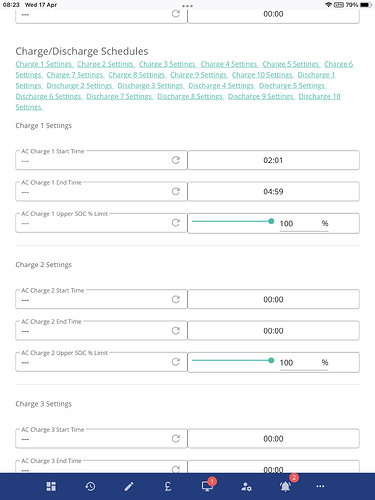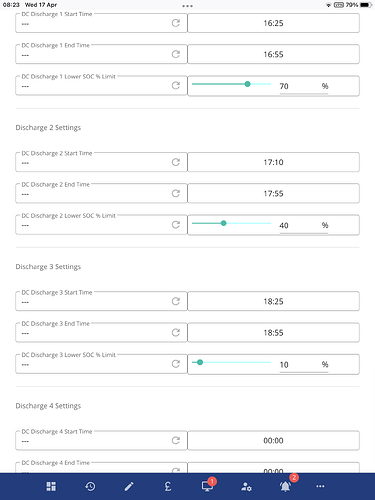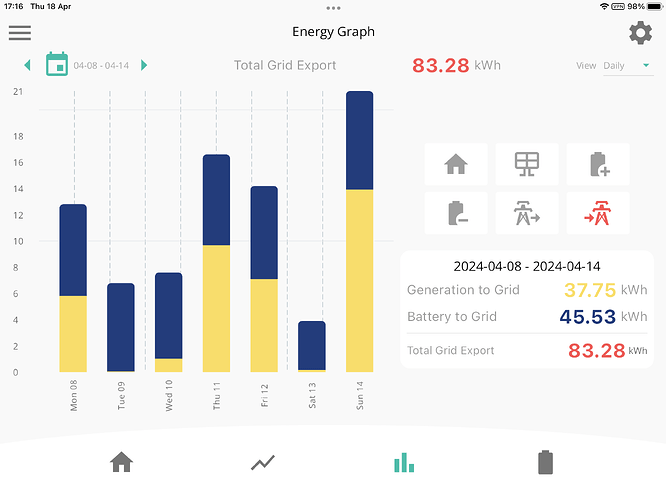The Cosy Octopus tariff offers two 3-hour periods a day (4 - 7 am; 1 - 4 pm) in which electricity costs 60% of its normal price and 1 period (4 - 7 pm) in which it costs 160% of its normal price. Although the other Octopus smart tariffs don’t have the afternoon period with a reduced price, they do have the same period of 4 - 7 pm with a premium price. The problem is therefore much the same: how to set the battery charge periods to maximise the amount of solar PV stored while avoiding consuming grid electricity between 4 and 7 pm.
With solar panels (3 kW), batteries (14 kWh), a 3.6 kW Gen 3 inverter and an average heat-pump demand of 2kW when it’s 5°C or 1 kW when it’s 10°C, the standard “Eco” setting doesn’t suffice at this time of year (Spring). My demand for electricity often exceeds what I’m generating and I want to avoid grid electricity between 4 and 7 pm.
My solution, which I offer as a suggestion and to receive comments, is to aim to fill the battery by sunset. I reckon that when the sun is shining the average generation is 2 kW (it peaks at 3.5 kW). This amounts to 2 kWh = 15% charge / hour. So I can add about 30% charge from solar between 4 pm and sunset. I should therefore aim for 70% charge = 10 kWh at 4pm.
If I set a charge period from 1 - 4 pm with a target of 70%, the system would charge at 3.6 kW (= 25% charge / hour) from 1 pm. Unless the battery was completely depleted at 1 pm, it would reach 70% charge some time before 4 pm. If it happened to be a sunny day, the battery might start at 50% charge at 1 pm and reach 70% by 4 pm without any boost from the grid.
So having a single charge period from 1 - 4 pm is a bad idea. But I need to be able to charge for the entire period if the battery happens to be completely depleted at 1 pm and there’s minimal solar PV. My solution is to split 1 - 4 pm into 6 half-hourly charge periods with target charges of 20%, 30%, 40%, 50%, 60% and 70%. These allow the system to top up the battery from the grid to my desired profile if the charge in the battery has been depleted without being refilled by solar PV. But if there’s lots of solar PV, the battery charge at the start of each half-hour will exceed the target charge for that half-hour, so it won’t take any grid electricity.
The other period of charge with Cosy Octopus is 4 - 7 am (but it might as well be any 3-hour period overnight). As there’s no solar PV, there’s no advantage to splitting this period and the only issue is to set the target charge. In some ways this is harder than the afternoon periods, because there’s a lot of solar PV which could be generated between 7 am and 1 pm, and also a lot of electricity which could be consumed. I have gone for a 40% target charge but reckon that I need to keep this under review based on the weather forecast: increase it if it’s going to be cold and dull; reduce it if it’s going to be warm and sunny.
Note that, with the exception of the target for the overnight charging period, this approach doesn’t require me to adjust targets day-to-day based on the weather. Fortunately, the overnight charging period is the first of the day so appears on the phone app and is easy to adjust; the other charging periods can only be set on the web UI from the cog on the inverter screen. I still need to adjust the targets with the seasons, but that’s always going to be the case.
Those on other tariffs don’t have the luxury of an afternoon period of reduced-price electricity so they will need to make as much use of the overnight charge period as they can without impairing their ability to store solar PV. They will want to set the target charge for 4 pm to whatever they need to carry them through to 7 pm. The same approach that I have used will work for them of having a series of half-hour periods leading up to 4 pm with rising target charges which are only triggered if not enough solar PV has been generated.




